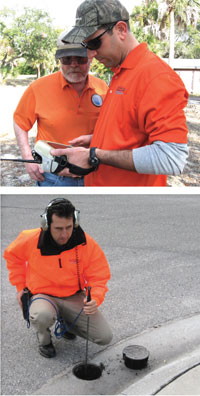Top: Carl Wright, District senior water conservation analyst, left, and Nick Makris, District staff water conservation analyst, use the District’s computerized leak correlator to pinpoint the location of a known leak. Above: Nick Makris listens to a water valve to determine if he can hear a leak sound.
Two weeks of work by District staff cost the City of Tarpon Springs nothing, but could save the city thousands of gallons of water per day.
District water conservation analysts from the Conservation & Water Use Outreach Section brought sophisticated leak detection equipment to Tarpon Springs as part of the District’s Utility Outreach Program. Improving communication between the District and the more than 190 public supply utilities in the region is the focus of this new Utility Outreach Program that officially kicked off last summer. The outreach program provides tremendous benefit to utilities by offering District tools, programs and resources that can help them meet the District’s regulatory requirements, conserve water and save money.
One of those tools is the District’s Urban Mobile Lab, which provides a free service to municipal water utilities to assist them in locating leaks — particularly those that do not present themselves aboveground.
“It’s no secret that water, particularly in Florida, is a precious and limited resource,” said Ray Page, City of Tarpon Springs Utilities superintendent. “It makes sense that the utility has an interest in finding and stopping leaks in the distribution system.”
Locating leakage from water distribution systems is increasingly important. The cost of water leakage in the U.S. is in the billions of dollars per year, and the true cost is considerably higher when factors such as property damage, liability and investment in limited water resources are included. The average leak found by the District’s 21-year-old leak detection program wastes about two gallons of water per minute.
District water conservation analysts Carl Wright and Nick Makris teamed up with Page and Joe Lucas, a city water technician. They evaluated 1,248 points over 14 days, mostly at hydrants and valves near the surface of the ground. They discovered 23 leaks of varying size. Some were fixed on the spot; others were repaired later or are scheduled for repair.
“I am a huge proponent of the leak detection program,” said Ken Herd, the District’s water supply program director. “Finding leaks helps local utilities reduce their power and chemical use, which saves them money. It’s a key part of our Utility Outreach Program.”
Before the outreach program began, many of the utilities were unaware of the leak detection program and other tools the District had to offer.
“Through the outreach program, we’re able to target some of these tools where they’re really needed,” said Herd. “We still have some utilities who are working to get their water usage below the per capita limit. The leak detection program can help those utilities by being a part of that process.”
The per capita limit requires utilities to use 150 gallons or less per person per day. The District’s 10 central and southern counties (from Pasco to Charlotte) have been required to meet the 150-gallon-per-day limit for a number of years. Within the District’s six northern counties (Levy, Lake, Marion, Sumter, Citrus and Hernando), utilities that are above the 150-gallon-per-day limit must meet it by the end of 2019.
“The outreach program is an example of state and local governments working together for mutual benefit,” said Herd. “It’s helping the local utilities save money and helping the District meet water conservation goals.”
The Tarpon Springs Utilities superintendent agreed. “Water resource conservation is particularly important in the Tampa Bay region with our limited water resources and high population,” said Page. “This leak detection partnership provided significant results that will conserve water and benefit the entire region.”
For more information on the Utility Outreach Program and leak detection services, visit the District’s website at WaterMatters.org/utility/ or call the District’s Conservation & Water Use Outreach Section at (352) 796-7211, ext. 4285.

